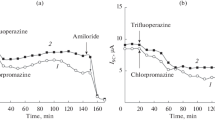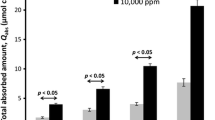Summary
Amiloride (0.1mm) as well as Ca++ (10mm) inhibit Na+ transport across frog skin by blocking Na+ entrance across the outer barrier of the epithelium. The inhibition produced by amiloride consists of an “early” and a “late” phase which together account for almost a total inhibition of the short-circuit current (SCC). The analysis of the time course indicates that the two phases are due to the inhibition of superficially and deeply located Na sites, respectively. Ca++, instead, only blocks a fraction of the SCC, and this fraction seems to correspond to the inhibition of the same population of Na sites blocked by the “late” phase of amiloride effect. The location of the two populations of Na sites as well as the possible relationship between them are discussed in terms of maturation of the outermost cell layer.
Similar content being viewed by others
References
Benos, D.J., Simon, S.A., Mandel, L.J., Cala, P.M. 1976. Effect of amiloride and some of its analogues on cation transport in isolated frog skin and thin lipid membranes.J. Gen. Physiol. 68:43
Biber, T.U.L. 1971. Effect of changes in transepithelial transport on the uptake of sodium across the outer surface of the frog skin.J. Gen. Physiol. 58:131
Biber, T.U.L., Curran, P.F. 1970. Direct measurement of uptake of sodium at the outer surface of the frog skin.J. Gen. Physiol. 56:83
Cereijido, M., Curran, P.F. 1965. Intracellular electrical potentials in frog skin.J. Gen. Physiol. 48:543
Cereijido, M., Moreno, J.H., Rodríguez Boulan, E., Rotunno, C.A. 1972. On the evaluation of fluxes across the outer border of the epithelium.In: Role of Membranes in Secretory Processes. L. Bolis, editor. p. 279. North Holland, Amsterdam
Cereijido, M., Rabito, C.A., Rodríguez Boulan, E., Rotunno, C.A. 1974. The sodium-transporting compartment of the epithelium of frog skin.J. Physiol. (London) 237:555
Cereijido, M., Rotunno, C.A. 1971. The effect of antidiuretic hormone on Na movement across frog skin.J. Physiol. (London) 212:119
Crank, J. 1956. In the Mathematics of Diffusion. p. 45. Oxford University Press, London
Curran, P.F., Cereijido, M. 1965. K fluxes in frog skin.J. Gen. Physiol. 48:1011
Curran, P.F., Gill, J.R. 1962. The effect of calcium on sodium transport by frog skin.J. Gen. Physiol. 45:625
Curran, P.F., Herrera, F.C., Flanigan, W.J. 1963. The effect of Ca and antidiuretic hormone on Na transport across frog skin. II. Sites and mechanisms of action.J. Gen. Physiol. 46:1011
Cuthbert, A.W. 1971. Neurohypophyseal hormones and sodium transport.Phil. Trans. R. Soc. B. 262:103
Cuthbert, A.W. 1973. Evidence for multiple forms of receptors for amiloride in transporting epithelia.Eur. J. Pharmacol. 33:187
Dörge, A., Nagel, W. 1970. Effect of amiloride on sodium transport in frog skin. II. Sodium transport pool and unidirectional fluxes.Pfluegers. Arch. Gesamte Physiol. 321:91
Eigler, J., Crabbé, J. 1969. Effects of diuretics on active sodium transport in amphibian membranes.In: Renal Transport and Diuretics. K. Thurau and H. Jahmarker, editors. pp. 195–208. Springer-Verlag, Berlin
Eisenman, G. 1960. On the elementary atomic origin of equilibrium ionic specificity.In: Membrane Transport and Metabolism. A. Kleinzeller and A. Kotyk, editors. p. 172. Academic Press, London-New York
Farquhar, M.G., Palade, G.E. 1965. Cell junction in amphibian skin.J. Cell Biol. 26:263
Kidder, G.W., Cereijido, M., Curran, P.F. 1964. Transient changes in electrical potential differences across frog skin.Am. J. Physiol. 207:935
Koefoed-Johnsen, V., Ussing, H.H. 1958. The nature of the frog skin potential.Acta Physiol. Scand. 42:298
Kreevoy, M.M., Wewerka, E.M. 1967. A filter paper diaphragm technique for diffusion coefficients.J. Phys. Chem. 71:4150
Gebhardt, U., Fuchs, W., Lindemann, B. 1972. Resistance response of frog skin to brief and long lasting changes of (Na)0 and (K)0.In: Role of Membranes Secretory Processes. L. Bolis, editor. p. 284. North Holland, Amsterdam
Morel, F., Leblanc, G. 1975. Transient current changes and Na compartmentalization in frog skin epithelium.Pfluegers Arch. 388:135
Moreno, J.H., Reisin, I.L., Rodríguez Boulan, E., Rotunno, C.A., Cereijido, M. 1973. Barriers to sodium movement across frog skin.J. Membrane Biol. 11:99
Nagel, W. 1976. The intracellular electrical potential profile of the frog skin epithelium.Pfluegers Arch. 365:135
Nielsen, R., Tomilson, R.W.S. 1970. The effect of amiloride on sodium transport in normal and moulting frog skin.Acta Physiol. Scand. 79:238
Rabito, C.A., Rodríguez Boulan, E., Cereijido, M. 1973. Effect of the composition of the inner bathing solution on transport properties of the frog skin.Biochim. Biophys. Acta 311:630
Rotunno, C.A., Vilallonga, F., Fernández, M., Cereijido, M. 1970. The penetration of sodium into the epithelium of frog skin.J. Gen. Physiol. 55:716
Salako, L.A., Smith, A.J. 1970. Changes in sodium pool and kinetics of sodium transport in frog skin produced by amiloride.Br. J. Pharmacol. 39:99
Vôute, C.L., Ussing, H.H. 1970. Quantitative relation between hydrostatic pressure gradient, extracellular volume and active sodium transport in the epithelium of the frog skin (R. temporaria).Exp. Cell Res. 62:375
Whittembury, G. 1964. Electrical potential profile of the toad skin epithelium.J. Gen. Physiol. 47:795
Author information
Authors and Affiliations
Rights and permissions
About this article
Cite this article
Rabito, C.A., Rotunno, C.A. & Cereijido, M. Amiloride and calcium effect on the outer barrier of the frog skin. J. Membrain Biol. 42, 169–187 (1978). https://doi.org/10.1007/BF01885369
Received:
Issue Date:
DOI: https://doi.org/10.1007/BF01885369




